Janome 8100 Instruction Manual
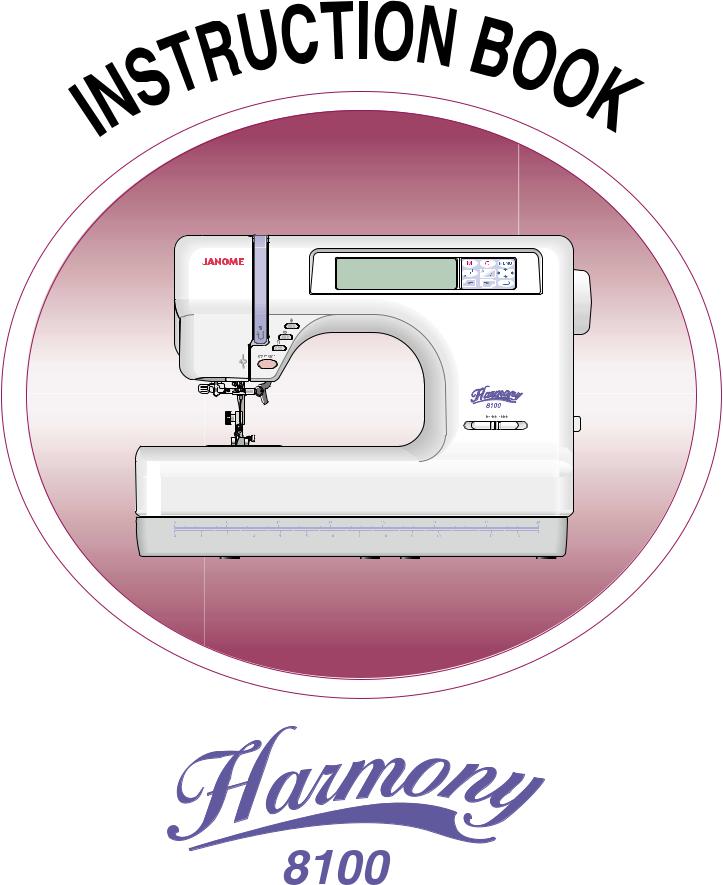
IMPORTANT SAFETY
INSTRUCTIONS
When using an electrical appliance, basic safety precautions should always be followed, including the following: Read all instructions before using this appliance.
DANGER – To reduce the risk of electric shock:
1.An appliance should never be left unattended when plugged in. Always unplug this sewing machine from the electric outlet immediately after using and before cleaning.
2.Always unplug before replacing a sewing machine bulb. Replace bulb with same type rated 13.2 V d.c., 3 Watts.
WARNING– To reduce the risk of burns, fire, electric shock, or injury to persons:
1.Do not allow to be used as a toy. Close attention is necessary when this sewing machine is used by or near children.
2.Use this appliance only for its intended use as described in this owner’s manual.
Use only attachments recommended by the manufacturer as contained in this owner’s manual.
3.Never operate this sewing machine if it has a damaged cord or plug, if it is not working properly, if it has been dropped or damaged, or dropped into water.
Return this sewing machine to the nearest authorized dealer service center for examination, repair, electrical or mechanical adjustment.
4.Never operate the appliance with any air opening blocked. Keep ventilation openings of this sewing machine and foot controller free from accumulation of lint, dust and loose cloth.
5.Never drop or insert any object into any opening.
6.Do not use outdoors.
7.Do not operate where aerosol (spray) products are being used or where oxygen is being administered.
8.To disconnect, turn all controls to the off (“O”) position, then remove plug from outlet.
9.Do not unplug by pulling on cord. To unplug, grasp the plug, not the cord.
10.Keep fingers away from all moving parts. Special care is required around the sewing machine needle.
11.Always use the proper needle plate. The wrong plate can cause the needle to break.
12.Do not use bent needles.
13.Do not pull or push fabric while stitching. It may deflect the needle causing it to break.
14.Switch this sewing machine off (“O”) when making any adjustment in the needle area, such as threading the needle, changing the needle, threading the bobbin or changing the presser foot, and the like.
15.Always unplug this sewing machine from the electrical outlet when removing covers, lubricating, or when making any other adjustments mentioned in this owner’s manual.
SAVE THESE INSTRUCTIONS
TABLE OF CONTENTS
SECTION I NAMES OF PARTS
Names of Parts . . . . . . . . . . . . . . . . . . . . . . . . . . 3–4
Detachable Extension Table . . . . . . . . . . . . . . . . 4
Standard Accessories . . . . . . . . . . . . . . . . . . . . . . 5
SECTION II GETTING READY TO SEW
Connecting Machine to Power Supply . . . . |
. . . . 6 |
|
Controlling Sewing Speed. . . . . . . . . . . . . . . |
. . . . 7 |
|
• To Use Start/Stop Button . . . . . . . . . . . . |
. . . 7 |
|
• |
Speed Setting Lever . . . . . . . . . . . . . . . . |
. . . 7 |
• To Use Foot Control . . . . . . . . . . . . . . . . |
. . . 7 |
|
Winding the Bobbin . . . . . . . . . . . . . . . . . . . . |
. 8–9 |
|
• Removing the Bobbin . . . . . . . . . . . . . . . |
. . . 8 |
|
• Winding the Bobbin . . . . . . . . . . . . . . . . |
. . . 8 |
|
• |
Inserting the Bobbin . . . . . . . . . . . . . . . . |
. . . 9 |
Threading the Machine . . . . . . . . . . . . . . . . . |
10–11 |
|
• Threading the Machine . . . . . . . . . . . . . . |
. . 10 |
|
• Needle Threader . . . . . . . . . . . . . . . . . . . |
. . 10 |
|
• Drawing Up the Bobbin Thread . . . . . . |
. . 11 |
|
Presser Foot Lifter . . . . . . . . . . . . . . . . . . . . . . |
. . 11 |
|
Pressure Dial . . . . . . . . . . . . . . . . . . . . . . . . . . |
. . 12 |
|
Up/Down Needle, Auto-Lock and Reverse |
|
|
Buttons . . . . . . . . . . . . . . . . . . . . . . . . . . . . |
. . 12 |
|
• Up/Down Needle Button . . . . . . . . . . . . |
. . 12 |
|
• Auto-Lock Button . . . . . . . . . . . . . . . . . . |
. . 12 |
|
• Reverse Button . . . . . . . . . . . . . . . . . . . . |
. . 12 |
|
Selecting Needle and Thread . . . . . . . . . . . . . |
. . 13 |
|
Adjust the Top Thread Tension . . . . . . . . . . |
. . 14 |
|
• Choose the Correct Tension . . . . . . . . . |
. . 14 |
|
• |
Tension is too Tight . . . . . . . . . . . . . . . . . |
. . 14 |
• |
Tension is too Loose . . . . . . . . . . . . . . . . |
. . 14 |
SECTION III STRAIGHT,BUTTONHOLE
AND UTILlTY SEWING
Selecting Patterns (Ordinary Sewing) . . . . . . . . 15
• Changing the Screen . . . . . . . . . . . . . . . . . . 15
• Selecting Patterns . . . . . . . . . . . . . . . . . . . . 16 Language Selection Key . . . . . . . . . . . . . . . . . . . 16 Straight Seam Sewing . . . . . . . . . . . . . . . . . . 17–20
• Up/Down Needle Key . . . . . . . . . . . . . . . . . 17
• Starting to Sew . . . . . . . . . . . . . . . . . . . . . . . 17
• Changing Sewing Direction . . . . . . . . . . . . 17
• Finishing Sewing . . . . . . . . . . . . . . . . . . . . . 18
• Seam Allowance Lines . . . . . . . . . . . . . . . . 19
• Turn a Square Corner . . . . . . . . . . . . . . . . . 19
• Sewing on Heavy Fabrics . . . . . . . . . . . . . . 19
• Setting Stitch Length and Left/Right Needle Position . . . . . . . . . . . . . . . . . . . . . . . . . . . . . 20
• Manual Stitch Length . . . . . . . . . . . . . . . . . 20
• Variable Needle Position . . . . . . . . . . . . . . 20 Straight Stitches . . . . . . . . . . . . . . . . . . . . . . . . . . 21 Zigzag Stitch . . . . . . . . . . . . . . . . . . . . . . . . . . . . . 22
• Manual Stitch Width and Length . . . . . . . 22 Overcasting . . . . . . . . . . . . . . . . . . . . . . . . . . . 23–24
• Zigzag Stitch . . . . . . . . . . . . . . . . . . . . . . . . . 23
• Multiple Zigzag . . . . . . . . . . . . . . . . . . . . . . 23
• Overcasting . . . . . . . . . . . . . . . . . . . . . . . . . . 23
• Knit Stitch . . . . . . . . . . . . . . . . . . . . . . . . . . . 24
• Double Overedge Stitch . . . . . . . . . . . . . . . 24
• Overlock Stitch . . . . . . . . . . . . . . . . . . . . . . 24 Sensor Buttonholes . . . . . . . . . . . . . . . . . . . . 25–28
• Three Types of Buttonhole . . . . . . . . . . . . 25
• Preparation for Sewing . . . . . . . . . . . . . . . . 25
• To Sew . . . . . . . . . . . . . . . . . . . . . . . . . . . 25–27
• To Alter Buttonhole Stitch Width and Density . . . . . . . . . . . . . . . . . . . . . . . . . . . . . . . 27
• Rounclend and Keyhole Buttonhole . . . . 28 Corded Buttonhole . . . . . . . . . . . . . . . . . . . . . . . 29 Zipper Sewing . . . . . . . . . . . . . . . . . . . . . . . . 30–31
• To Snap On the Zipper Foot . . . . . . . . . . . 30
• Fabric Preparation . . . . . . . . . . . . . . . . . . . . 30
• To Sew . . . . . . . . . . . . . . . . . . . . . . . . . . . 30–31 Blind Stitch Hemming . . . . . . . . . . . . . . . . . . . . . 32
• Changing Needle Position . . . . . . . . . . . . . 32 Darning . . . . . . . . . . . . . . . . . . . . . . . . . . . . . . . . . 33 Eyelets . . . . . . . . . . . . . . . . . . . . . . . . . . . . . . . . . 34 Shell Stitch . . . . . . . . . . . . . . . . . . . . . . . . . . . . . . 34 Appliqué . . . . . . . . . . . . . . . . . . . . . . . . . . . . . . . . 34 Drawn work . . . . . . . . . . . . . . . . . . . . . . . . . . . . . 35 Scallop Hems . . . . . . . . . . . . . . . . . . . . . . . . . . . . 36 Patchwork . . . . . . . . . . . . . . . . . . . . . . . . . . . . . . . 36 Fagoting. . . . . . . . . . . . . . . . . . . . . . . . . . . . . . . . . 37 Elastic Stitch . . . . . . . . . . . . . . . . . . . . . . . . . . . . . 37 Smocking . . . . . . . . . . . . . . . . . . . . . . . . . . . . . . . . 37 Pintack . . . . . . . . . . . . . . . . . . . . . . . . . . . . . . . . . . 38 Decorative Stitch . . . . . . . . . . . . . . . . . . . . . . . . . 38 Cross Stitch . . . . . . . . . . . . . . . . . . . . . . . . . . . . . . 38 Changing Needles . . . . . . . . . . . . . . . . . . . . . . . . 39 To Attach and Remove Presser Feet . . . . . . . . 39 Adjusting Pattern Balance . . . . . . . . . . . . . . . . . 40
1
SECTION IV PROFESSIONAL STYLE |
|
EMBROIDERY |
|
Getting Ready to Sew Professional Style |
|
Embroidery . . . . . . . . . . . . . . . . . . . . . . . . . . . . |
. . . 41 |
• Interfacing . . . . . . . . . . . . . . . . . . . . . . . . . . |
. . 41 |
• Selecting Needle and Thread . . . . . . . . . . . |
. . 41 |
• Template . . . . . . . . . . . . . . . . . . . . . . . . . . . . |
. . 41 |
Using Built-in Monogramming Mode . . . . . . . |
42–44 |
• To Raise or Lower the Feed Dog . . . . . . . |
. . 42 |
• To Attach Embroidery Foot P . . . . . . . . . . |
. . 42 |
• To Set the Fabric in the Embroidery Hoop |
. . 43 |
• Threading the Machine . . . . . . . . . . . . . . . . |
. . 44 |
• To Attach the Embroidery Hoop to the |
|
Machine . . . . . . . . . . . . . . . . . . . . . . . . . . . . . . . . |
. . 44 |
Sewing Built-in Letters and Numbers . . . . . . . |
45–50 |
• To Select Letter Style . . . . . . . . . . . . . . . . . |
. . 45 |
• To Compose Words, Etc. . . . . . . . . . . . . . . |
. . 46 |
• To Sew . . . . . . . . . . . . . . . . . . . . . . . . . . . . |
47–48 |
• If the Thread Breaks While Embroidering . |
. . 49 |
• Combining Letters in Script Style |
|
(Upper & Lowercase) . . . . . . . . . . . . . . . . . . |
. . 50 |
• European Letters in Block Style |
|
(Lowercase) . . . . . . . . . . . . . . . . . . . . . . . . . |
. . 50 |
Embroidery with Optional Memory Cards . . 51–54 |
|
• To Insert the Memory Card . . . . . . . . . . . . |
. . 51 |
• To Eject the Memory Card . . . . . . . . . . . . |
. . 51 |
•To Set the Fabric in the Embroidery Hoop . . 52
•Embroidery with Large Pattern Memory
Card . . . . . . . . . . . . . . . . . . . . . . . . . . . |
. . . . 52 |
• Skipping . . . . . . . . . . . . . . . . . . . . . . . . . . |
. . . . 53 |
• Embroidery with Large Pattern Memory |
|
Card . . . . . . . . . . . . . . . . . . . . . . . . . . . |
. . . . 54 |
Embroidery with Blank Memory Card and Scan’n . |
|
Sew, Scan’n SewPC (Optional Accessories) |
. . . . 54 |
When Messages Appear on Screen . . . . . . . . |
. . . . 55 |
SECTION V CARE OF YOUR MACHINE
Care of Your Machine. . . . . . . . . . . . . . . . . . . . 55–57
• Replancing the Light Bulb . . . . . . . . . . . . . . . 56
• Cleaning the Bobbin Holder . . . . . . . . . . . . . 56
• Exposing the Hook Race . . . . . . . . . . . . . . . . 56
• Cleaning the Hook Race . . . . . . . . . . . . . . . . 57
• Replacing the Bobbin Holder . . . . . . . . . . . . 57
Troubleshooting . . . . . . . . . . . . . . . . . . . . . . . . . 58–60
2

q
!7
!6
!5
!4
@2
|
|
SECTION 1 NAMES OF PARTS |
|
|
Names of Parts |
!8 |
|
q Pressure dial |
|
|
w Flip-top sewing instruction panel |
|
|
e Thread tension dial |
|
|
r Spool holder (Large) |
|
|
t Bobbin winder spindle |
|
|
y Key pad |
|
|
u Visual touch screen |
e r |
|
i Speed setting lever |
|
o Up/down needle button |
|
w |
|
!0Auto-lock button |
|
t |
|
|
!1Reverse button |
|
|
|
|
|
|
!2Start/stop button |
|
|
!3Extension table (Accessory box) |
|
|
!4Hook cover plate release button |
y!5Hook cover plate
u!6Needle threader !7Thread cutter
!8Screen sharpness adjustment dial*
!9Memory key (see page 33 and 46) @0Clear key (see page 46) @1Menu key (see pages 15 and 42)
@2Letter size key (see pages 45 and 48)
i@3Letter style key (see page 45)
|
|
|
|
|
o |
@4Space check key (see page 48 and 49) |
|
|
|
|
!3 !2 |
!1!0 |
@5Previous page key (see page 15) |
||
|
|
|
|
@6Next page key (see page 15) |
|||
|
|
|
|
|
|
@7Return key (see pages 15, 27 and 48) |
|
|
|
|
|
@3 |
|
|
|
!9 |
@0 |
@1 |
* Brightness of the screen can be changed by turning |
||||
the screen sharpness adjustment dial (located beneath |
|||||||
|
|
|
|
|
|
||
M |
|
|
C |
MENU |
the flip-top sewing instruction panel). |
||
|
|
|
|||||
S M |
L |
A |
a |
|
@4 |
|
|
|
|
|
|
||||
@5 @6 @7
3
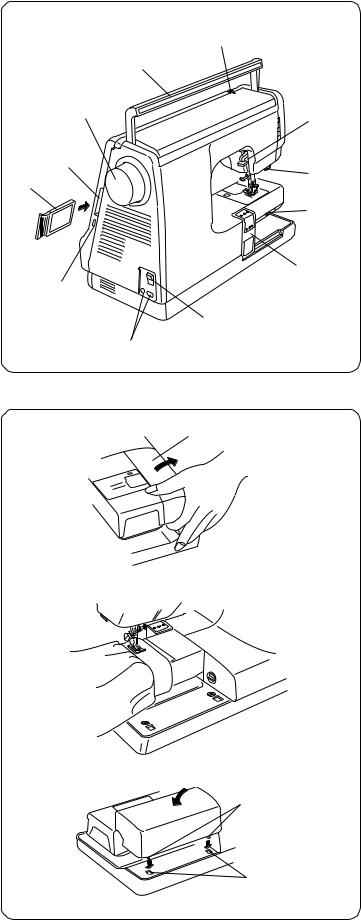
Names of Parts
wq Carrying handle
|
q |
w Thread take-up lever |
|
|
|
e Presser foot lifter |
|
!2 |
|
r Buttonhole lever |
|
e |
t Drop feed lever |
||
|
|||
|
|
y Carriage |
|
!1 |
r |
u Power switch |
|
!0 |
i Machine sockets |
||
|
|||
|
t |
o Card eject button |
|
|
|
!0Memory card |
|
|
|
!1Memory card slot |
y!2Handwheel
o
u
i
q |
Detachable Extension Table |
||
For Free Arm Sewing |
|||
|
|||
|
To remove, lift out the extension table toward you as |
||
|
illustrated. |
||
|
Advantages of free arm sewing: |
||
|
* |
Avoid fabric bunching around the needle when |
|
|
|
bar tacking to reinforce pockets, plackets and |
|
|
|
waistlines. |
|
|
* |
For stitching sleeves, waistbands, pants legs, or |
|
|
|
any circular garment area. |
|
|
* |
For darning socks or mending knees, elbows, or |
|
|
|
areas of wear in children’s clothes. |
|
|
For Flat-bed Sewing |
||
|
Position the tabs on the base grooves and push down |
||
|
gently. |
||
|
q Extension table |
||
|
w Tabs |
||
w |
e Base grooves |
||
e
4
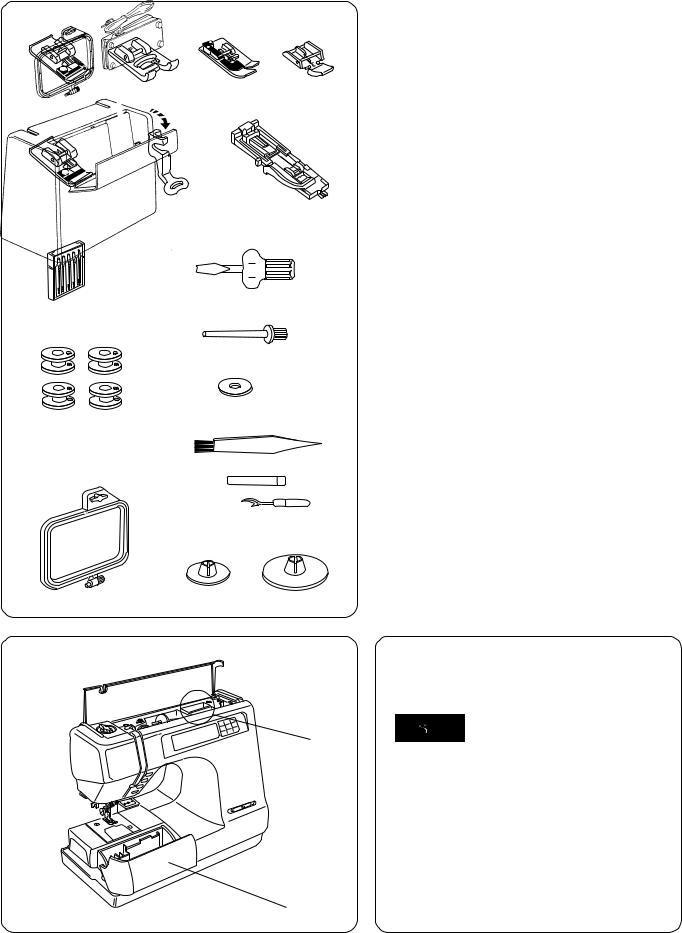
q |
w |
e |
t |
y |
u |
io
!1
!0
!2
!3
!5
!4
!6
Standard Accessories
r
q C: Overedge foot w F: Satin stitch foot e G: Blind hem foot r E: Zipper foot
t M: Overcasting foot y P: Embroidery foot
u R: Automatic buttonhole foot i Set of needles
o Screwdriver
!0Bobbins
!1Additional spool pin
!2Spool pin felt
!3Lint brush
!4Seam ripper
!5Embroidery hoop No. 1
!6Small spool holder
!7Large spool holder
!8Foot compartment
!9Extension table (Accessory Box)
@0Power supply cord
@1Foot control
@2Carrying case
!7
@1
!5
@0
!8
@2
!9
5
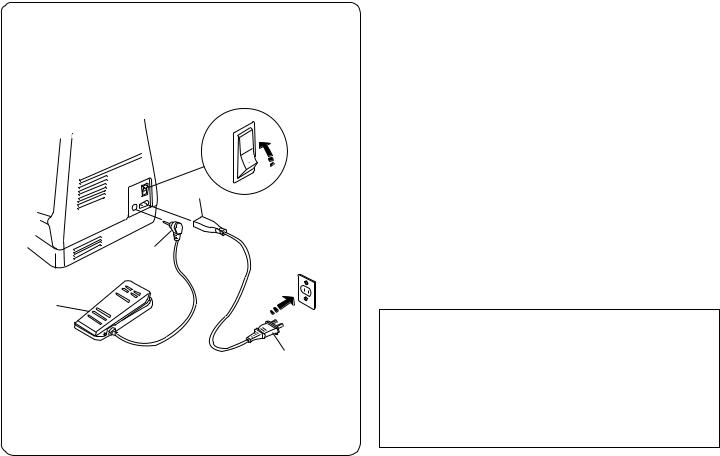
SECTION II GETTING READY TO SEW
Connecting Machine to Power Supply
Before connecting the power cord, make sure the voltage and frequency shown on the machine conform to your electrical power.
r¡ To sew using foot control
*Turn off the power switch, and insert the foot control plug q, machine plug w into the machine
and power supply plug e into the wall in this order.
|
ON |
q Foot control plug |
w Machine plug |
|
|
|
|
||
|
OFF |
e Power supply plug |
r Power switch |
|
w |
t Power supply cord |
y Foot control |
||
|
t¡ To sew using start/stop button
q |
|
* Turn off the power switch, insert only the machine |
|
|
|
plug w into the machine and power supply plug e |
|
|
|
|
|
|
|
|
into the wall. |
y |
|
* |
Turn on the power switch. |
|
|
|
|
|
|
Note: |
|
|
e |
* The foot control cannot be used in embroidery mode. |
|
|
* If you turn off the power switch, wait 5 seconds |
||
|
|
||
|
|
|
before turning it on again. |
|
|
* |
After turning on the power it is not abnormal to |
|
|
|
hear a slight humming sound coming from the |
|
|
|
internal motor. |
For Your Safety
1. While in operation, always keep your eye on the sewing area, and do not touch any moving parts such as the thread take-up lever, handwheel or needle.
2. Always turn off the power switch and unplug from the power supply:
* When leaving the machine unattended. * When attaching or removing parts.
* When cleaning the machine.
3. Do not place anything on the foot control, except in use.
Operating Instructions:
The symbol “0” of a switch indicates the “off ” position of a switch.
“For appliances with a polarized plug (one blade wider than the other ).
To reduce the risk of electric shock, this plug is intended to fit in a polarized outlet only one way. If the plug does not fit fully in the outlet, reverse the plug. If it still does not fit, contact a qualified electrician to install the proper outlet. Do not modify the plug in any way.”
“Foot Controller Model 21371 or Model 21249 for use with Sewing Machine Model 8100.”
(For U.S.A. market only).
6
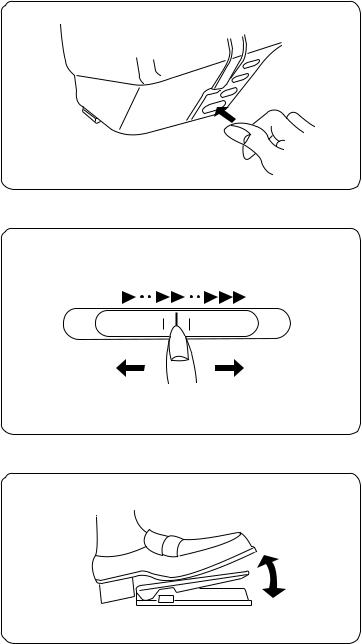
Controlling Sewing Speed
• To Use Start/Stop Button
To use this button you must disconnect the foot control from the machine.
This button can be used for Professional style Embroidery. It can be also be used for ordinary sewing, if you wish. The machine starts running slowly for the first few stitches, then it runs at the speed set by the speed setting lever.
*You cannot use the Start/Stop button when the foot c ontrol is connected to the sewing machine.
• Speed Setting Lever
Sewing speed can be controlled by the speed setting lever.
To increase sewing speed, slide the lever to the right.
To decrease sewing speed, slide the lever to the left.
• To Use Foot Control
Sewing speed can be varied by the foot control. The harder you press on the foot control, the faster the machine runs.
*To use the foot control, slide the speed setting lever to “High”.
7
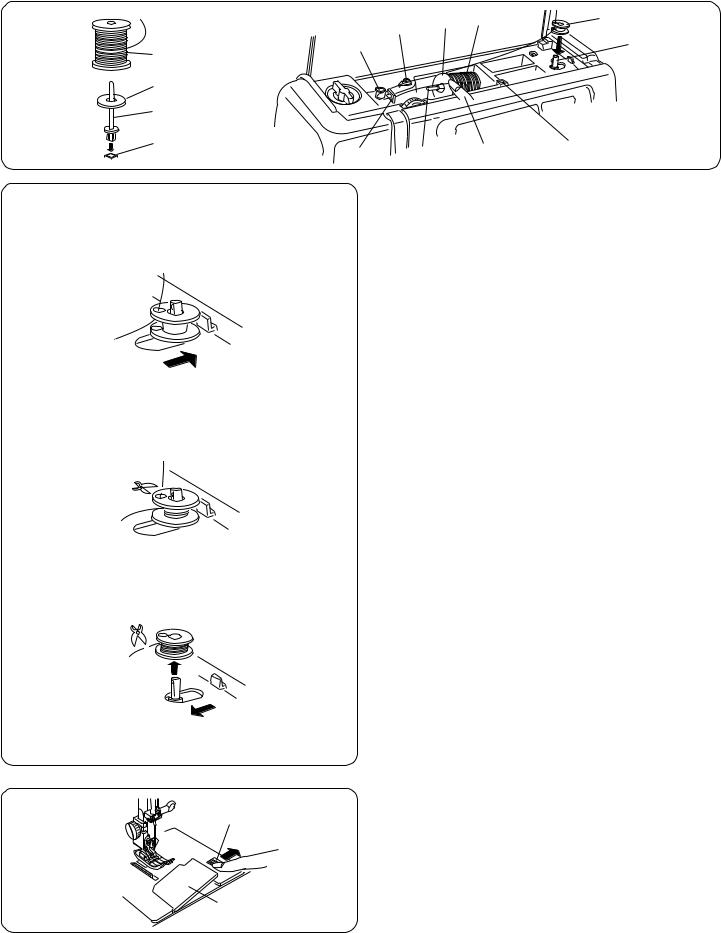
|
v |
e |
w |
b |
|
|
|
|
|
w |
c |
|
|
u |
|
|
|
|
|
t |
|
|
|
|
r |
|
|
|
|
y |
x q |
|
z |
y |
|
|
|||
|
|
|
Winding the Bobbin
zLift up the spool pin. Place the spool of thread on the spool pin with the thread coming off the spool as
n |
shown. |
||
Attach the large spool holder, and press it firmly |
|||
|
|||
|
against the spool of thread. |
||
|
* |
The small spool holder is used with narrow or |
|
|
|
small spools of thread. |
|
|
* |
To use the additional spool pin, guide the upper |
|
|
|
thread as shown in x, c and then v. |
|
|
x Pass the thread under the thread guide. |
||
|
c Guide the thread around the thread guide. |
||
m |
v Pass the thread through the thread guide. |
||
b Thread through the hole in the bobbin from the |
|||
|
|||
|
inside to the outside. Put the bobbin on the bobbin |
||
|
winder spindle. |
||
|
n Push the bobbin to the right. |
||
m With the free end of the thread held in your hand, depress the foot control. Stop the machine when it has made a few turns, and cut the thread close to the hole in the bobbin.
, |
, Depress the foot control again. When the bobbin is |
||
fully wound, it will stop automatically. Return the |
|||
|
|||
|
bobbin winder to its original position by moving the |
||
|
spindle to the left, and cut the thread as shown. |
||
|
* The machine will not sew until the spindle is in |
||
|
the left position. |
|
|
|
q Spool pin w Spool |
e Spool holder |
|
|
r Additional spool pin |
t Felt |
|
|
y Additional spool pin hole |
||
|
u Bobbin winder spindle |
|
|
|
¡ Removing the Bobbin |
||
q |
Slide the hook cover plate release button to the right, |
||
|
and remove the cover plate. |
||
qHook cover plate release button wHook cover plate
w
8
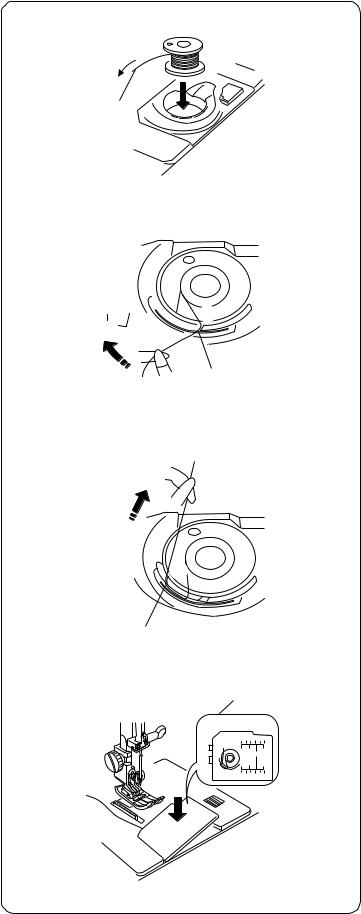
z
q
x

 A
A
w
c
B
e
r
v
1/8 3/8 5/8
10
¡ Inserting the Bobbin
zPlace the bobbin in the bobbin holder with the thread running off in the counterclockwise
direction. q End of thread
xGuide the thread into the Notch A on the front side of the bobbin holder.
Draw the thread to the left, sliding it between the
tension spring blades. w Notch A
cContinue to draw the thread lightly until the thread slips into Notch B.
Pull out about 15 cm (6" ) of thread. e Notch B
vAttach the hook cover plate.
Check the threading by referring to the chart shown
on the hook cover plate. r Threading chart
9
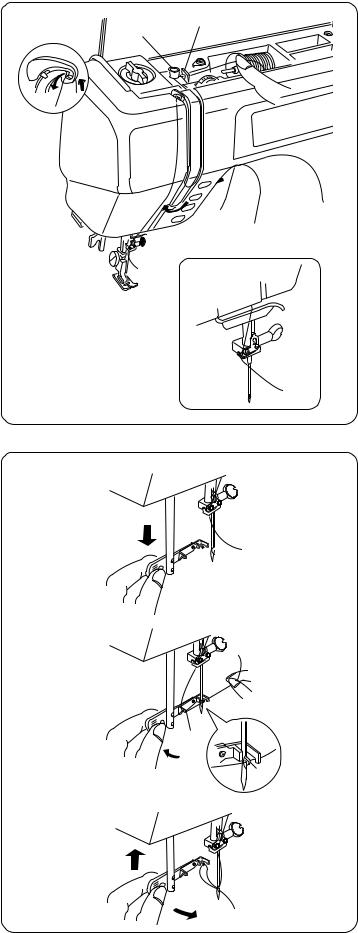
|
q |
Threading the Machine |
|
|
|
x |
w |
¡ Threading the Machine |
|
|
|
|
|
z Raise the presser foot lifter. Press the up/down |
|
needle button twice to raise the needle (see page 10). |
|
|
Hold the upper thread as shown and pass the |
|
|
thread under the thread guide q. |
|
|
Guide the thread around thread guide w as |
|
|
shown. |
|
|
Pull the thread down and around the check spring |
|
z |
holder from right to left, then pull up the thread. |
|
x Firmly draw the thread from right to left into the |
||
|
||
|
eye of the take-up lever. |
|
|
Then down through the lower thread guide. |
|
|
c Slide the thread behind the needle bar thread guide |
|
|
from the left. |
|
|
Thread the needle from front to back or use the |
|
|
needle threader. |
|
c |
q Thread guide |
|
w Thread guide |
||
|
||
|
¡ Needle Threader |
|
z |
z Raise the needle to its highest position. Pull down |
|
the needle threader knob as far as it will go. |
||
|
||
|
x Turn the knob in the direction of the arrow in the |
|
|
illustration, then insert Hook q into the needle |
|
|
eye. Lead the thread around Guide w and under |
|
|
Hook q. |
|
|
c Turn the knob in the direction of the arrow in the |
|
x |
illustration, drawing the thread loop through the |
|
|
needle. |
|
|
v Pull the thread through the needle eye. |
|
|
* The needle threader can be used with a #11 to |
|
|
#16 needle or a Janome Blue Tip needle. Thread |
|
w |
size 50 to 100 should also work well. |
|
|
q Hook |
|
q |
w Guide |
|
c v |
|
10

¡ Drawing Up the Bobbin Thread
z
z Raise the presser foot. Hold the needle thread lightly with your left hand.
x Press the up/down needle button twice to pick up x the bobbin thread. Draw up the needle thread
together with a loop of bobbin thread.
q Up/down needle button
q
c |
c Slide 10 cm (4" ) of both threads to the back under |
|
the presser foot. |
||
|
Presser Foot Lifter
The presser foot lifter raises and lowers your presser foot. You can raise it about 1/4" higher than the normal up position for easy removal of the presser foot or to help you place heavy fabric under it.
q |
q Presser foot lifter |
|
11
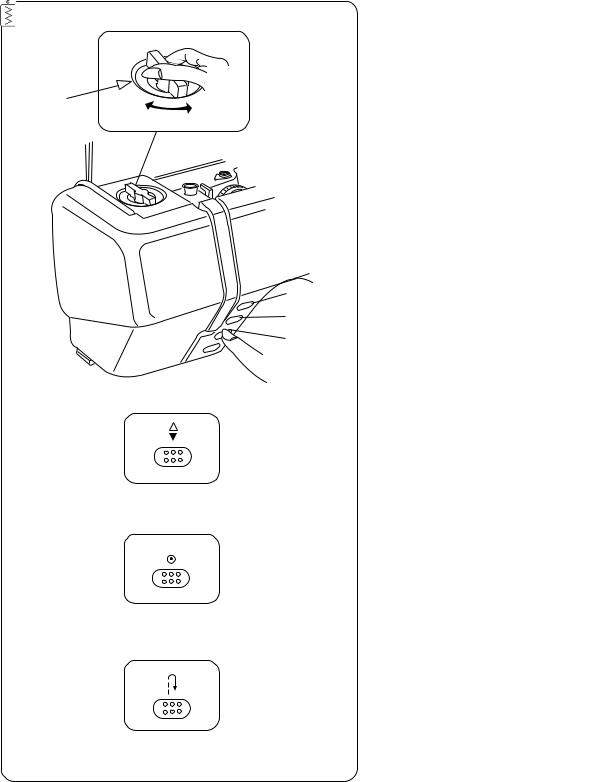
|
Pressure Dial |
|
The pressure dial should be set at “ 3 ” for regular |
|
sewing. Reduce the pressure to “ 2 ” for appliqué, cut |
|
work, drawn work, basting and embroidery. |
q |
Set the pressure to “ 1 ” when sewing chiffon, lace, |
|
organdy and other fine fabrics. Velours and knits with |
|
a lot of stretch may also require a “ 1 ” setting. |
|
Align the number on the dial with the setting mark. |
|
q Setting mark |
Up/Down Needle, Auto-Lock and Reverse Buttons
w
|
e |
¡ Up/Down Needle Button |
|
|
||
|
|
|
|
|
|
|
|
r |
When this button is pressed, the needle bar goes down |
||||
|
and stops in the lowest position. When pressed again, |
|||||
|
|
|||||
|
|
the needle bar goes up and stops in the highest |
||||
|
|
position. |
|
|
|
|
w |
|
w Up/down needle button |
|
|
|
|
|
|
|
|
|
|
|
|
|
¡ Auto-Lock Button |
|
|
|
|
|
|
When stitches |
, |
, |
or |
are selected, the |
|
|
machine will immediately sew locking stitches and |
||||
|
|
automatically stop when the auto-lock button is |
||||
e |
|
pressed. When sewing all other stitches, the machine |
||||
|
will sew locking stitches at the end of the current |
|||||
|
|
pattern and automatically stop. |
|
|
||
|
|
e Auto-lock button |
|
|
|
|
|
|
¡ Reverse Button |
|
|
|
|
|
|
When stitches |
, |
, |
or |
are selected, the |
r |
|
machine will sew in reverse while the reverse button |
||||
|
|
is pressed. If you press the reverse button when |
||||
|
|
sewing all other stitches, the machine will |
||||
|
|
immediately sew locking stitches and automatically |
||||
|
|
stop. |
|
|
|
|
r Reverse button
12
Selecting Needle and Thread
For general sewing use needle size 11 or 14. fabrics, so the fabric will not be marred. without fraying the needle thread.
A fine thread and needle should be used for sewing lightweight Heavy fabrics require a needle large enough to pierce the fabric
In the needle case you will find Two size 14s, two size 11s and one blue tipped needle. Use a blue tipped needle to eliminate skipped stitches when sewing knits and synthetic fabrics.
There are also specialty needles available from your sewing machine dealer. A denim needle with a sharp tip is used to effectively pierce dense fabrics such as denim and canvas. For topstitching, a special topstitching needle with a larger eye accommodates heavier weight thread. Leather needles punch small holes in leather and suede allowing the thread to follow through the hole.
Check your needles frequently for rough or blunt tips. Snags and runs in knits, fine silks and silk-like fabrics are permanent and are often caused by damaged needles.
Always purchase a good quality thread. It should be strong, smooth and consistent in thickness.
WEIGHT |
FABRIC |
TYPE OF NEEDLE |
NEEDLE |
||
SIZE |
|||||
|
|
|
|||
Very Light |
Chiffon, Georgette, Fine Lace, Organdy, Organdy |
Universal |
9 (65) |
||
Net, Tulle |
Ball Point |
9 (65) |
|||
|
|||||
|
|
|
|
|
|
|
Batiste, Voile, Lawn, Pure Silk, Crepe de Chine, |
|
|
|
|
|
Sheer Crepe, Chambray, Handkerchief Linen, |
Blue Tipped Needle |
11 |
(75) |
|
|
Gingham, Challis, Percale, Wool Crepe, Peau de |
||||
|
Universal |
11 |
(75) |
||
|
Soie, Taffeta, Satin, Silk Surah, Satin-backed |
||||
|
|
12 |
(80) |
||
Light |
Crepe, Qiana |
|
|||
|
|
|
|||
|
|
|
|
|
|
|
Single Knits, Jersey, Swimwear, Tricot |
Blue Tipped Needle |
11 |
(75) |
|
|
Ball Point |
11 |
(75) |
||
|
|
||||
|
|
|
|
|
|
|
Leather, Suede |
Wedge Point Leather |
11 |
(75) |
|
|
Needle |
||||
|
|
|
|
||
|
Flannel, Velour, Velvet, Muslin, Velveteen, Poplin, |
|
|
|
|
|
Corduroy, Broadcloth, Linen, Chintz, Gabardine, |
Universal |
14 |
(90) |
|
|
Felt, Terry, Burlap, Quilted Fabrics |
|
|
|
|
|
|
|
|
|
|
Medium |
Double Knits, (synthetic and natural) Stretch |
Ball Point |
14 |
(90) |
|
|
Velour, |
|
|
|
|
|
Stretch Terry, |
|
|
|
|
|
Sweater Knits |
|
|
|
|
|
|
|
|
|
|
|
Leather, Vinyl, Suede |
Wedge Point Leather |
14 |
(90) |
|
|
Needle |
||||
|
|
|
|
||
|
Denim, Sailcloth, Ticking |
Denim Needle |
16 |
(100) |
|
|
|
|
|
|
|
Heavy |
Double Faced Wool, Heavy Coating, Fake Fur, |
Universal |
16 |
(100) |
|
Drapery Fabrics |
|||||
|
|
|
|
||
|
|
|
|
|
|
|
Leather, Suede |
Wedge Point Leather |
16 |
(100) |
|
|
Needle |
||||
|
|
|
|||
|
|
|
|
||
Very Heavy |
Canvas, Duck, Upholstery Fabrics |
Universal |
18 |
(110) |
|
|
|
|
|
|
|
|
Topstitching for Special Finish |
Topstitching Needle |
11 |
(75) |
|
|
14 |
(90) |
|||
|
|
|
|||
|
|
|
|
|
|
13
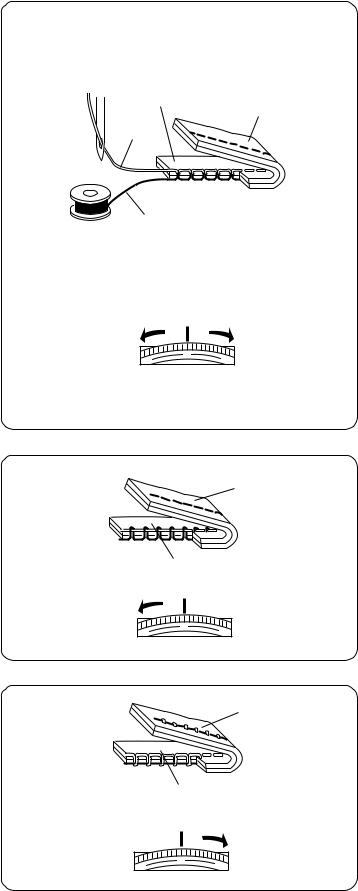
e r
q
w
t |
4 |
y |
|
5 |
3 |
||
|
w
q
e
5 |
4 |
3 |
|
w
q
e
5 |
4 |
3 |
|
Adjust the Top Thread Tension
¡ Choose the Correct Tension
For Straight Stitch:
The ideal straight stitch will have threads locked between the two layers of fabric, as shown left (magnified to show detail).
If you look at the top and bottom of the seam, you will notice that there are no gaps; that each stitch is smooth and even.
When adjusting top thread tension, the higher the number, the tighter the top thread.
Results depend on;
*stiffness and thickness of the fabric
*number of fabric layers
*type of stitch
q Needle thread (Top thread) w Bobbin thread (Bottom thread) e Right side of fabric
r Wrong side of fabric t To loosen
y To tighten
¡ Tension is too tight
The bobbin thread shows through on the right side of the fabric and it will feel bumpy.
Turn the dial to the left to loosen the top thread tension.
q Right side of fabric w Wrong side of fabric e To loosen
¡ Tension is too loose
The top thread shows through on the wrong side of the fabric and it will feel bumpy.
Turn the dial to the right to tighten the top thread tension.
q Right side of fabric w Wrong side of fabric e To tighten
14
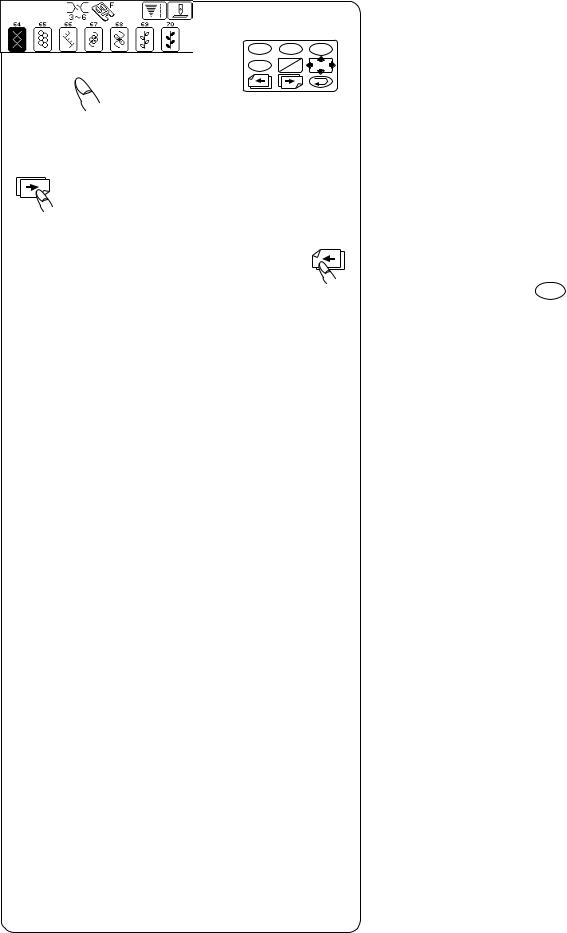
z
x d
c
A
d
B
C
D
E
F
G
H
I
J
SECTION III STRAIGHT,BUTTONHOLE AND UTILlTY SEWING
M C MENU
L |
A |
a |
S M |
|
d
Pattern Selection (Utility Stitches)
• How to scroll the display screen
zWhen you turn the power switch the MENU screen is displayed.
xPress  key.
key.
The display screen shows A .
cYou can get the stitch patterns from B to J display screen as shown, when you turn on the power switch.
Press the  key to scroll through screens B to J. (To return to a previous screen, press the
key to scroll through screens B to J. (To return to a previous screen, press the  key.)
key.)
*Press the  or MENU key to go back to the main MENU screen.
or MENU key to go back to the main MENU screen.
15
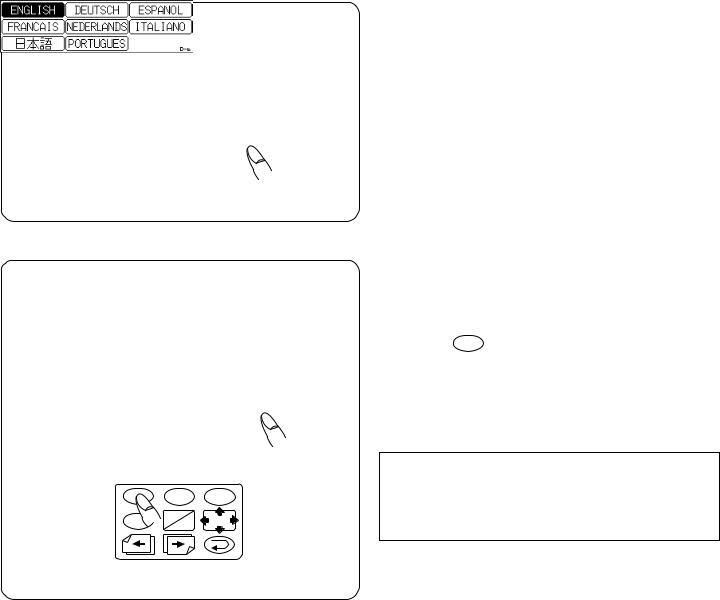
q w |
e r |
 q
q
C |
MENU |
A |
a |
S |
¡ Selecting Patterns
Press the center of a desired pattern on the screen. q Appropriate top thread tension is displayed. w A suitable foot is displayed.
eStitch Width and Length Key : 
When the  key is pressed, the stitch width and length can be adjusted (see page 22).
key is pressed, the stitch width and length can be adjusted (see page 22).
rUp/Down Needle Key : 
When this key is pressed, the needle bar alternates between up and down position (see page 17).
Language Selection Key
*Press  key.
key.
*Select the language you need.
* Press the M key to memorize the language selected.
The screen will automatically be returned to the main menu.
q Language selection key
Note:
Regardless of which language is selected on the machine, any message stored in the Memory Card is shown on the visual touch screen in English only.
16
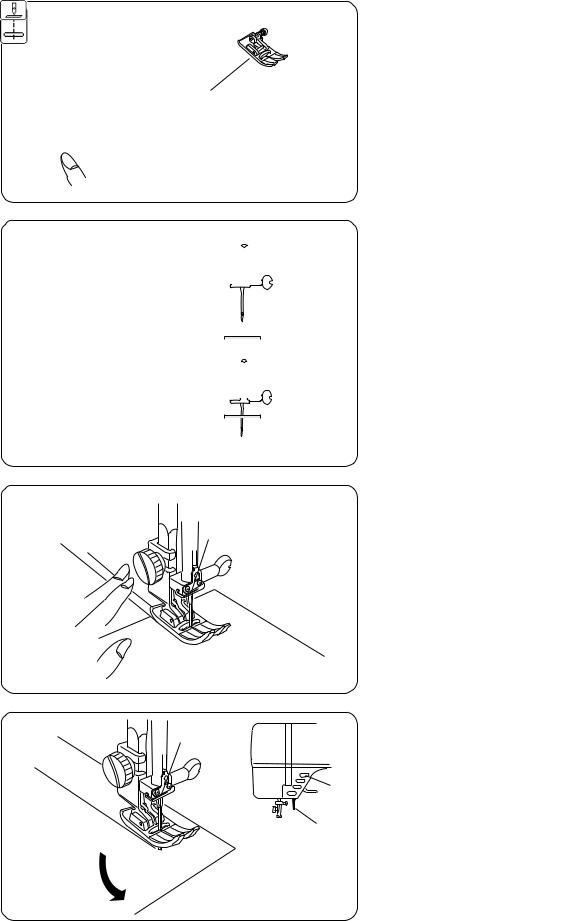
// 



 /
/ 



Straight Seam Sewing
¡ Up/Down Needle Key :
Pressing this key toggles back and forth between the needle up  and needle down
and needle down  display.
display.
Needle Up
If you want the needle to be in the up position after sewing a seam, press this key until the needle up display appears: 
Needle Down
If you would like the needle to end in the down position after sewing a seam, press this key until the needle down display appears: 
¡ Starting to Sew
Raise the presser foot and position the fabric next to a seam guide line on the needle plate (see page 19). Lower the needle to the point where you want to start.
Lower the presser foot and pull the threads toward the back. Depress the foot control. Gently guide the fabric along the seam guide line letting the fabric feed naturally.
¡ Changing Sewing Direction
Stop the machine and bring the needle down into the fabric by pressing the up/down needle button.
qRaise the presser foot.
Pivot the fabric around the needle to change sewing
wdirection as desired. Lower the presser foot. q Up/down needle button
w Presser foot lifter
17
